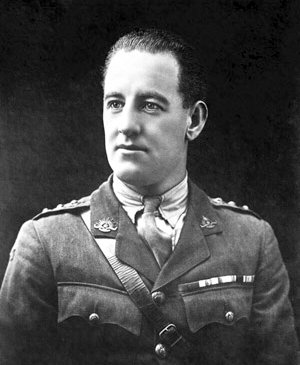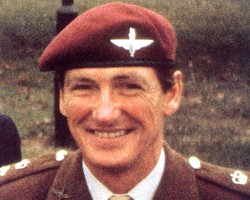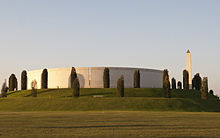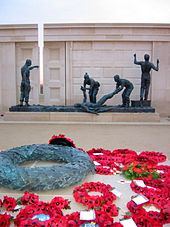
Ian Rank-Broadley FRBS is a British sculptor who has produced many acclaimed works, among which are several designs for British coinage and the memorial statue of Princess Diana at Kensington Palace in London unveiled on her 60th birthday in 2021.
The George Cross (GC) is the highest award bestowed by the British government for non-operational gallantry or gallantry not in the presence of an enemy. In the British honours system, the George Cross, since its introduction in 1940, has been equal in stature to the Victoria Cross, the highest military gallantry award. It is awarded "for acts of the greatest heroism or for most conspicuous courage in circumstance of extreme danger", not in the presence of the enemy, to members of the British armed forces and to British civilians. Posthumous awards have been allowed since it was instituted. It was previously awarded to residents of Commonwealth countries, most of which have since established their own honours systems and no longer recommend British honours. It may be awarded to a person of any military rank in any service and to civilians including police, emergency services and merchant seamen. Many of the awards have been personally presented by the British monarch to recipients or, in the case of posthumous awards, to next of kin. The investitures are usually held at Buckingham Palace.

The Australian War Memorial is Australia's national memorial to the members of its armed forces and supporting organisations who have died or participated in wars involving the Commonwealth of Australia and some conflicts involving personnel from the Australian colonies prior to Federation. Opened in 1941, the memorial includes an extensive national military museum.

Keith Payne, is an Australian recipient of the Victoria Cross, the highest decoration for gallantry "in the presence of the enemy" awarded to members of the British and Commonwealth armed forces. Payne's VC was awarded for his actions during the Vietnam War. Aged 89, he is the last living Australian recipient of the original "Imperial" Victoria Cross.

Albert Jacka, was an Australian recipient of the Victoria Cross, the highest decoration for gallantry "in the face of the enemy" that can be awarded to members of the British and Commonwealth armed forces. Jacka was the first Australian to be decorated with the VC during the First World War, receiving the medal for his actions during the Gallipoli Campaign. He later served on the Western Front and was twice more decorated for his bravery.
The Cross of Valour was established in 1975 as the highest Australian Bravery Award. The awards were established as part of the institution of the Australian Honours System. The Cross of Valour has been awarded to five Australian civilians and, although there has been no Australian military recipient, they would be eligible in situations where normal honours to the military do not apply.

Lieutenant Colonel Herbert Jones,, known as H. Jones, was a British Army officer and posthumous recipient of the Victoria Cross (VC). He was awarded the VC after being killed in action during the Battle of Goose Green for his actions as commanding officer of the 2nd Battalion, Parachute Regiment, during the Falklands War.

John Hurst Edmondson, VC was an Australian recipient of the Victoria Cross, the highest award for gallantry in the face of the enemy that can be awarded to British and Commonwealth forces.
The National Memorial Arboretum is a British site of national remembrance at Alrewas, near Lichfield, Staffordshire. Its objective is to honour the fallen, recognise service and sacrifice, and foster pride in the British Armed Forces and civilian community.
The Royal Irish Rangers was a regular infantry regiment of the British Army with a relatively short existence, formed in 1968 and later merged with the Ulster Defence Regiment in 1992 to form the Royal Irish Regiment.

Colour Sergeant Johnson Gideon Beharry, is a British Army soldier who, on 18 March 2005, was awarded the Victoria Cross, the highest military decoration for valour in the British and Commonwealth armed forces, for saving members of his unit, the 1st Battalion Princess of Wales's Royal Regiment, from ambushes on 1 May and again on 11 June 2004 at Al-Amarah, Iraq. He sustained serious head injuries in the latter engagement. Beharry was formally invested with the Victoria Cross by Queen Elizabeth II on 27 April 2005.
A Message from the Falklands: The Life and Gallant Death of David Tinker is a book about Lieutenant David Hugh Russell Tinker, a Royal Navy supply officer who was killed in action during the Falklands War. His father, Hugh Tinker, published the book after Tinker's death as an edited collection of Tinker's letters.
Sergeant Alistair Slater, MM was a British Army soldier who served in 'B' Squadron, Air (7) Troop, 22 Special Air Service (SAS), who was killed on 2 December 1984 in a confrontation with the Provisional Irish Republican Army in Kesh, a village in County Fermanagh in Northern Ireland. The operation led to the deaths of Provisional Irish Republican Army volunteers Antoine Mac Giolla Bhrighde and Kieran Fleming, and the arrest of the others. The IRA members had been attempting to ambush a Royal Ulster Constabulary police car with a land mine at the time. Slater was posthumously awarded the Military Medal for his role in the action.
Captain Gavin John Hamilton, MC was a British Army infantry soldier. He was the Officer Commanding 19 (Mountain) Troop, D Squadron, 22 Special Air Service during the Falklands War when he was killed in action behind enemy lines on West Falkland.

The Victoria Cross (VC) is the highest and most prestigious award of the British honours system. It is awarded for valour "in the presence of the enemy" to members of the British Armed Forces and may be awarded posthumously. It was previously awarded by countries of the Commonwealth of Nations, most of which have established their own honours systems and no longer recommend British honours. It may be awarded to a person of any military rank in any service and to civilians under military command. No civilian has received the award since 1879. Since the first awards were presented by Queen Victoria in 1857, two-thirds of all awards have been personally presented by the British monarch. The investitures are usually held at Buckingham Palace.

Corporal Sarah Louise Bryant, of the British Army's Intelligence Corps, was the first British servicewoman killed in Afghanistan.

Blue Beach Military Cemetery at San Carlos is a British war cemetery in the Falkland Islands holding the remains of 14 of the 255 British casualties killed during the Falklands War in 1982, and one other killed in early 1984. It is situated close to where 3 Commando Brigade had its initial headquarters after landing on 21 May 1982.

The Civilian Service Medal (Afghanistan) is awarded by the British government to civilians (and members of the UK Armed Forces in certain non-combat roles) to recognise service since 19 November 2001 in the transition to democracy in Afghanistan.














